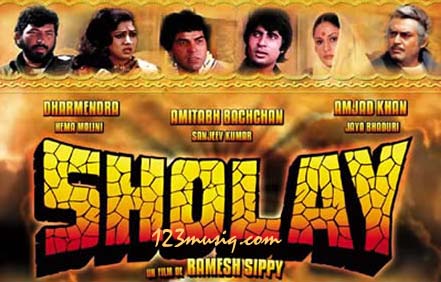YESTERYEAR CINEMA "SHOLAY"

Directed by: Ramesh Sippy
Produced by: G.P. Sippy
Written by : Javed Akhtar Salim Khan
Starring : Dharmendra, Sanjeev Kumar Hem Malini
Amitabh Bachchan, Jaya Bhaduri, Amjad Khan, Asrani
Music by : Rahul Dev Burman
Cinematography: Dwarka Divecha
Editing by: M.S. Shinde
Distributed by Sippy Films
Release date(s) 15 August 1975
Sholay (English: Embers) is an Indian film directed by Ramesh Sippy. It is the biggest hit in the history of Bollywood, India's Hindi film industry. Released on 15 August 1975, it stars Dharmendra, Sanjeev Kumar, Amitabh Bachchan, Hema Malini, Jaya Bhaduri and Amjad Khan. The movie, shot in the rocky terrain of Ramanagara, Karnataka, is the story of two petty criminals hired to capture a ruthless dacoit by the name of Gabbar Singh.
.

Directed by: Ramesh Sippy
Produced by: G.P. Sippy
Written by : Javed Akhtar Salim Khan
Starring : Dharmendra, Sanjeev Kumar Hem Malini
Amitabh Bachchan, Jaya Bhaduri, Amjad Khan, Asrani
Music by : Rahul Dev Burman
Cinematography: Dwarka Divecha
Editing by: M.S. Shinde
Distributed by Sippy Films
Release date(s) 15 August 1975
Sholay (English: Embers) is an Indian film directed by Ramesh Sippy. It is the biggest hit in the history of Bollywood, India's Hindi film industry. Released on 15 August 1975, it stars Dharmendra, Sanjeev Kumar, Amitabh Bachchan, Hema Malini, Jaya Bhaduri and Amjad Khan. The movie, shot in the rocky terrain of Ramanagara, Karnataka, is the story of two petty criminals hired to capture a ruthless dacoit by the name of Gabbar Singh.
.




